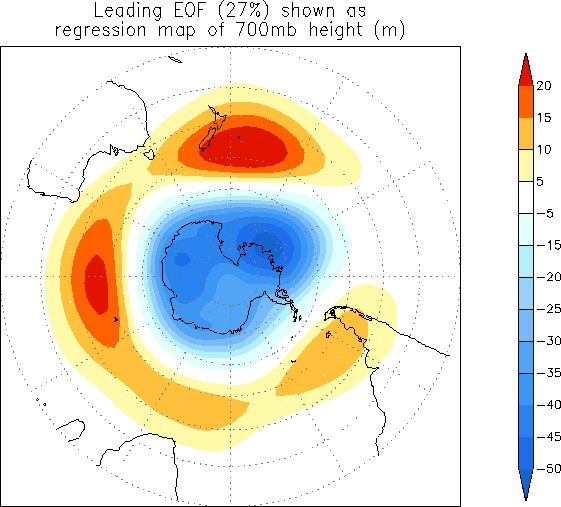 Fig
1a. CESM-WACCM4 control run leading EOF (25%) shown on regression
map of 700 mb height (standard deviation).
Fig
1a. CESM-WACCM4 control run leading EOF (25%) shown on regression
map of 700 mb height (standard deviation).
 Fig
1b. Climatological (1979-2010) leading EOF regressed onto 700 mb
heights (meters, from NOAA).
Fig
1b. Climatological (1979-2010) leading EOF regressed onto 700 mb
heights (meters, from NOAA).
Antarctic Oscillation (AAO) / Southern Annual Mode (SAM) Changes During Nuclear Winter
1. EOF Loading Pattern of the AAO
The Arctic and Antarctic Oscillations are the dominant modes of wintertime variability in each respective hemisphere. The positive mode of each oscillation index strengthens the polar vortex and the negative mode indicates a weakening. The negative mode is associated with poleward winds, which can lead to warming of the waters near Antarctica. The injection of black carbon into the upper troposphere and lower stratosphere heavily influences the phase and amplitude of these metrics which define the surface circulation. Theoretically, the presence of aerosols near the tropopause should create a differential heating gradient in the upper atmosphere during the winter, strengthening the circulation around the pole. This occurs in the Northern Hemisphere, as a +AO mode occurs during the winter and a -AO mode occurs during the summer. In the Southern Hemisphere, a negative mode of the AAO occurs during the summer months (DJF) but there is no strong positive mode of the AAO during the winter months (JJA). CESM-WACCM does a decent job at representing the circulation around the Southern Ocean and Antarctica. The loading pattern of 700 mb geopotential heights in CESM-WACCM4 (Fig 1a.), compared to the climatological loading pattern (Fig 1b.):
|
|
|
2.
AAO Changes During 150 Tg US-Russia Nuclear War
Monthly
evolution of the AAO (Fig 2a) and AO (Fig 2b) are shown during the
150 Tg US-Russia case. Key differences are that the AAO is mostly
negative (higher pressure at the South Pole compared to the Southern
Ocean) while the AO fluctuates wildly between positive during DJF and
negative during JJA. During JJA, the AAO is more negative than during
DJF, but it does not reverse phase like in the AO.
|
|
|
|
3.
-AAO Effect on Wind in the Southern Ocean
A
negative AAO is correlated with weaker surface winds over much of the
Southern Ocean, with an increase in surface winds closer to the
shores of Antarctica. The plot below plots show a composite of the
surface wind anomaly when the AAO is below -2.0 during the control
run (left) and the wind stress anomaly during the first DJF of the
150 Tg soot injection (right). Discrepancies include: increased wind
stress is not observed near New Zealand and to the west of Australia
during the nuclear war case. There is an increase in the surface
winds closer to the shore of Antarctica in the nuclear war case,
while there is a remarkable reduction for all places to the north.
|
|
|
Surface wind anomaly
during first four years of the 150 Tg US-Russia nuclear war:
DJF
Year 1, JJA Year 1
DJF
Year 4, JJA Year 4
DJF
Year 5, JJA Year 5
DJF
Year 6, JJA Year 6
DJF
Year 7, JJA Year 7
DJF
Year 8, JJA Year 8
DJF
Year 9, JJA Year 9
DJF
Year 10, JJA Year 10
Effect of -AAO on
surface winds: weakening over
Southern Ocean, strengthening along the New Zealand latitude
band.
Effect of +AAO on surface winds: strengthening
over the Southern Ocean, opposite of -AAO response.
Effect of -AAO on
Antarctic surface temperatures: more
meridional flow, warming over West Antarctica.
Effect of
+AAO on Antarctic surface temperatures: cooling
over West Antarctica.